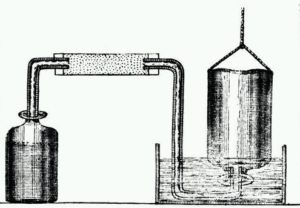“Our duty is to preserve what the past has had to say for itself, and to say for ourselves what shall be true for the future.” John Ruskin
That awesome and humbling duty befalls historians.
That said, this writer has experienced how much information is lost from as little as one-hundred, even fifty years ago, unless historians preserve it for the future. In today’s digital world, that information is no longer in danger of being forgotten.
Even these small articles about hydrogen and fuel cell history took many hours of investigating, and still, you may wish for more information.
Every nuance of history is a priceless treasure. We must treat it with reverence.
Heat and light for human habitation have been available in various forms for quite a long time. Beasts of burden carried people and goods from place to place for millennia. However, having an alternative to animals doing the heavy work for humans, did become a serious pursuit during the middle ages. What could move faster than man or beast? The imaginative Roger Bacon (1220 – 1292) also known as Doctor Mirabilis, wrote about “wagons which move with unbelievable speed without draft animals.” Of course, that was a long time coming.
A brief foray into the early history of engines, motors, and ‘autos mobilis’ (‘self-moving’ from Greek and Latin) will suffice to refresh our memory. Let’s skip steam-power; engines and motors are of interest at this time and for this sequence of articles. Also, a few dates important to this topic will follow to illustrate how slowly science and technology progressed in previous centuries, and how rapidly –comparatively– progress comes during our lifetime.
At the 1986 Canadian International Auto Show in Toronto, I picked up the pamphlet depicted below, and for thirty years, I have followed hydrogen related news from every available source at every opportunity. It also got me interested in its history.
Obviously, the reports in hydrogencarsnow.com cover mostly the present; the emphasis is on news; for that reason, I am undertaking to ‘connect the new with the old’. (The extensive picture series of ‘antique’ FCVs on this website won me over.)
I recently had the good fortune of receiving an invitation to a fuel cell seminar /workshop at the Hydrogenics Corporation in Toronto. (Separate article to follow.) This gave me a first-hand look at the state of the art in the fuel cell industry and the hydrogen economy. Hydrogenics is one of the major Canadian ‘all under one roof’ hydrogen research, production and testing firms; another one is Ballard Power Systems. Hydrogenics develops fuel cells for a variety of applications for General Motors and other companies. Having driven all manner of fuel cell vehicles at Hydrogenics’ headquarters, I can say, “been there, done that, got the T-shirt”. In spite of my preoccupation with vehicles, I will not neglect historical information about the other types of fuel cells, where relevant; Hydrogenics offered a glimpse at them as well. A great variety of fuel cell are being investigated and tested; hydrogen can be used in liquid or gas form, it can power IC engines or F-cells.
Much of the detailed information of the automotive pioneers’ daily progress, or struggles has been lost. Personal experience in researching the history of a rare 1902 ‘auto-buggy’ for a nearby museum has revealed this as extremely difficult. I caution readers to be aware that some dates you may find here could differ from your own knowledge. You will stumble across an example or two of this later on. I would be grateful for having my data enhanced with new pieces of evidence.
The information age has helped immeasurably to bring together bits of data from a diversity of resources. This in itself creates the possibility of obtaining conflicting results. You will find instances of this as we go on. Nonetheless, the internet makes it infinitely more efficient to assemble a series such as this, without spending tedious days at a library.
Most fuel cell information is only a few decades old. A seemingly new invention, the fuel cell is actually older than the battery as we know it. Moreover, hydrogen as a fuel was used long before petroleum, at the time when pioneers experimented to harness the power of coal dust and other previously unknown forms of energy; Steam engines and internal combustion engines (ICE) were first tried in the 1600s.
The early scientist Robert Boyle published information in 1671 about “flammable air” [gas] that originates when metals are exposed to acid; Today, that’s high school chemistry 101. Four hundred years ago, it was a scientific breakthrough. Christian Huygens, a Dutch physicist, is credited with having sketched an internal combustion engine in 1680, but he never built one.
Henry Cavendish isolated and extensively studied hydrogen around 1766. About twenty years later, Antoine Lavoisier split molecules of water into hydrogen and oxygen and then recombined them to make water again. (Additional research and information into this would go beyond the scope of this history article.)
Cavendish’s apparatus for making and collecting hydrogen
French-born officer Francois Isaac de Rivaz retired to Switzerland after his term of duty and at first experimented with steam-powered vehicles. In 1807, he fashioned a combustion engine and mixed various gasses to explore their combustibility. Rivaz used a mix of coal gas, air, and hydrogen for his experiments. Kevin Kantola already inserted an illustration of Rivaz’s engine and vehicle on this website — you will find it at the ‘History of Hydrogen Cars’.
There you have it, the earliest use of hydrogen as a fuel and the first hydrogen-powered vehicle. — WOW! In 1807! —— Have a look at the picture at the bottom of this page. That was four-hundred+ years ago, and we are still experimenting.
Next: Exploratory Times
Comments are closed here.
